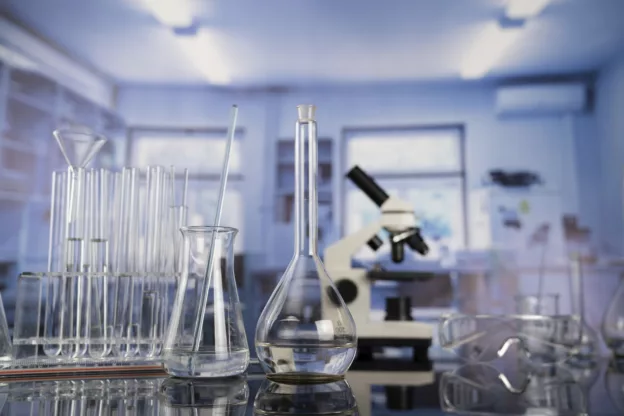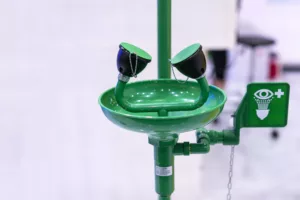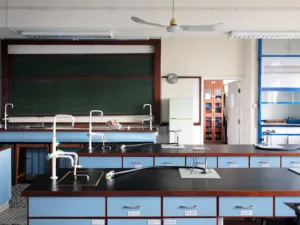“Duty or Standard of Care” is defined as an obligation, recognized by law, requiring conformance to a certain standard of conduct to protect others against unreasonable risk (Prosser et al., 1984). This means that school staff and school or district leaders (supervisors/administrators) are required to actively anticipate foreseeable harm to students and to others in the school. Furthermore, these leaders are required to act to prevent resultant injury or damage. “The breach of a particular duty owed to a student or others may lead to liability for both the teacher and the school district that employs that teacher.” (Ryan, 2001).
The legal definition of “negligence” is important for every educator to understand. In tort (civil) law, negligence, as defined by Barravecchio (2013) is “a failure to exercise the skill and care expected of a reasonable person in similar circumstances”. In civil (tort) law, negligence is made up of four elements:
- Presence of a Duty of Care: The law recognizes that the negligent party (the teacher, school, or district) has a Duty of Care (a responsibility to protect others from foreseeable harm) to the injured party.
- Breach of the Duty of Care: The negligent party has either caused harm by engaging in an unsafe action or failed to prevent foreseeable harm which resulted in injury.
- Proximate Cause: There is evidence that the breach of duty of care was the cause of the injury
- Damages: Actual loss or injury was sustained as a result of the breach that requires a legal (Roy & Love, 2017).
In the absence of specific laws or local policies, the standard of care expected of those having a duty of care is measured against any standards adopted by the profession, e.g. position statements adopted by the National Science Teaching Association (NSTA), the International Technology and Engineering Educators Association (ITEEA) or other similar professional organizations. The National Science Educator Leadership Association (NSELA) has released a detailed position statement for science education leaders which focuses on Duty of Care and gives specific guidance to education leaders about liability associated with hiring teaching staff, supervision of students, occupancy loads in science classrooms, and science teaching conditions (NSELA, 2016).
With the focus on Science, Technology, Engineering and Mathematics (STEM), many science teachers extend their classroom/laboratory to include the technology/engineering education laboratory. The best approach to safety in the STEM classroom is one of collaboration among all science and technology/engineering education faculty, administration, families, and students.
As a science/STEM teacher or supervisor, it is imperative for science/STEM teachers and supervisors to understand their duty of care owed to students. While the duty to protect students from unreasonable risk or harm remains the same for each individual, the behavior expected of a teacher to meet the duty of care changes with each situation. Teachers must act reasonably (objectively measured according to previous court rulings and best practices as recommended by professional associations.) to prevent harm to students. Specific behaviors that constitute meeting the duty of care owed to students are discussed below. Failure to perform those required behaviors can result in students being injured, sometimes fatally.
Failure to exercise duty of care may also result in teachers and school districts being sued for negligence. Teachers need to understand their state’s education law relative to any statutes, regulations, codes, and policies that specify a teacher’s duty of care and any possible consequences of breaching that duty. In some situations, a teacher or administrator may be sued for recklessness rather than for negligence. A claim of recklessness suggests that the defendant was aware of the risk of substantial harm but engaged in the behavior anyway. In 2014, a science teacher conducted a demonstration in which she poured ethanol on a student’s wrist (with the student’s permission) and set it on fire, claiming it would burn the alcohol without injuring the student (Mack, 2014). In this case, the teacher was charged with criminal recklessness. Both negligence and recklessness charges can result in substantial compensatory damages, but recklessness charges can also result in punitive damages in some states. Even if the teacher or administrator does not face legal consequences of negligence or recklessness, a breach of duty of care may result in termination of a teaching position or revocation of a teaching license.
The duty to maintain a safer science and engineering instructional space is shared by teachers, administrators, school boards, parents and students. Teachers and administrators need to communicate frequently in order to ensure that student safety remains a school priority.
The NSTA and the Council for State Science Supervisors have identified three overarching responsibilities of science teachers related to Duty of Care:
- Duty of Instruction
- Duty of Supervision
- Duty of Maintenance
To meet these responsibilities, teachers of science and STEM are expected to engage in the following behaviors to protect others from foreseeable harm:
Under Duty of Instruction:
- Duty to Notify of Safety Practices and Procedures
- Duty to ALWAYS Model Safety
- Duty to Warn of Foreseeable
Under Duty of Supervision:
- Duty to Notify of Safety Practices and Procedures
- Duty to ALWAYS Enforce Safety Consistently and Equitably Under Duty of Maintenance:
- Duty to Inspect for Safety (Before, During, and After activity)
- Duty to Remove Improperly Functioning Items
- Duty to Maintain Equipment and Facilities
Duty of Instruction: Duty of care requires that teachers provide safety instruction and the appropriate level of supervision during every lab activity that is done within their instructional space (e.g., classroom, laboratory or in the field.) Duty of Instruction also means that school districts are responsible for providing safety training to employees that may be exposed to hazardous materials and procedures.
- Duty to Notify Students of Safety Practices and Procedures – Teachers have a duty to discuss safety practices with students at the beginning of the school year, establishing the rules by which all experiments will be conducted. These safety practices should be outlined in a safety acknowledgement document which students and parents/guardians sign. These signed documents should be kept on file for at least the year during which the student is enrolled in the class, and no student should be permitted to participate in a laboratory activity without this document being on file. However, warning students of hazards in the class once at the beginning of the school year is not enough; safety must be reinforced every time students engage in any activity with the potential to cause harm. A review of safety protocols/procedures followed up by a demonstration should take place to teach students how to operate all tools and equipment safely.
- Duty to Instruct and ALWAYS model Safety – Students pay attention to what teachers do as well as to what they say. As STEM teachers we have a duty to provide safety instruction and model appropriate safety practices, such as wearing goggles and other appropriate personal protective equipment (PPE), for our students. Teachers should make sure that paraprofessionals and other adults in the room do the In addition, teachers must demonstrate for students how to perform various laboratory skills and use laboratory equipment in the safest possible manner.
- Duty to Warn Students of Hazards – Teachers must explicitly and specifically warn students of the dangers they may encounter during a laboratory This includes reminding students those scalpels and scissors are sharp. While it may seem as though this is common sense, teachers protect themselves by including a written warning on any laboratory materials, and making a verbal warning before the laboratory begins. Also, by providing safety signage around the lab, and warning students when they see a potentially hazardous situation created from their novice actions. Teachers should also document safety actions in their lesson plans as an objective and crucial part of their procedures for that lesson.
Duty of Supervision:
- Duty to Enforce Safety – All science and STEM teachers must exercise caution when students and student assistants are working with tools of any Personal protective equipment must be worn when using tools and teachers must keep students in their direct line of sight while tools are in use. Teachers must also ensure that students follow all safety procedures at all times. A student who is behaving inappropriately in the laboratory should be removed from that setting, with progressive disciplinary consequences to follow. In addition to referencing appropriate laboratory behavior in the safety acknowledgement form, schools should consider including a description of proper behavior in the laboratory in their Code of Conduct.
Teachers have the sole responsibility for the laboratory activities that are carried out in their instructional spaces; therefore, teachers must never leave their students unattended while any laboratory activity is in progress. Even if another adult (such as a para-professional, a specialist, or a substitute teacher) is present, unless that adult is certified in science education and has received annual safety training, the adult must not be in charge of a class engaging in a laboratory activity. Laboratory activities or science projects that are assigned for completion at home should be reviewed by teachers to be certain that they can be conducted safely and, if applicable, that students have the necessary personal protective equipment. Teachers may be held liable if a student or family member is injured by an experiment that the student was assigned to complete at home. These activities should be reviewed with parents/guardians to ensure that necessary supervision may occur.
Duty of Maintenance:
- Inspect for Safety – Teachers should inspect equipment prior to, during and after laboratory activities to ensure that they are in proper working Students should be asked to report any equipment that is not functioning properly, with no fear of punishment. Teachers should make sure that they perform any demonstrations and lab procedures themselves before doing them with their classes in order to ensure that they are aware of any and all safety precautions that should be taken.
- Maintain Equipment – Teachers have a duty to make sure that personal protective equipment and engineering controls are operating properly and meet manufacturer’s specifications, as well as OSHA specifications (or state health and environmental safety office specifications for non-OSHA states). If a piece of equipment is not functioning properly, it should be tagged and locked out of operation. The equipment should be repaired or replaced before being used again.
Teachers can often achieve safer laboratory experiences and show documented evidence of meeting the Duty of Care by using the following three step approach to planning:
- Hazard Analysis: A hazard analysis is a list of potential sources of harm (hazards) to persons, property, or the environment. An effective hazard analysis focuses on the relationship between the worker (student), the tasks, the materials used, and the work environment. Information for the hazard analysis may come from Safety Data Sheets, GHS compliant chemical labels, manufacturer’s specifications on tools, professional organization practices and other
- Risk Assessment: Using the hazard analysis, a risk assessment takes the results of the hazard analysis to determine the possible dangers to human health, safety, or the In other words, based on the hazards, how much of a danger is this activity going to be in the classroom? Factors associated with risk assessment include 1) Probability of harm: When considering the hazards, what is the likelihood this hazard may occur? and 2) Severity of harm. Will the hazard cause property damage, minor injury, severe injury, or death?
- Safety Actions: Through the hazard analysis and risk assessment, it can be determined which safety actions need to be implemented to mitigate the risks as much as possible.
The Center for Disease Control (CDC) and the National Institute for Occupational Safety and Health (NIOSH) have created a hierarchy of controls. Based on the hazard analysis and safety actions, activities can be evaluated to determine how the risk associated compares to the instructional value of the activity.
References
Barravecchio, J. A. (2013). The tort of negligence. Legaldate, 25(4), 4.
Globally Harmonized System for Hazard Communication: https://www.osha.gov/dsg/hazcom/global.html (accessed November 2018).
Hierarchy of Controls: from Center for Disease Control (CDC) and National Institute for Occupational Safety and Health (NIOSH) https://www.cdc.gov/niosh/topics/hierarchy/ (accessed November 2018).
Mack, J. L. Teacher charged with crime after classroom experiment goes awry. IndyStar, June 25, 2014; https://www.indystar.com/story/news/crime/2014/06/25/teacher-charged-crime-classroom-experiment-goes- awry/11358353/(accessed November 2018).
NSELA Safety Position Statements (2016): NSELA – Position Statements (accessed Dece
Prosser, W.L., Keeton, W. P., Dobbs, D. B., Keeton, R. E., & Owen, D. G. eds. (1984). Prosser and Keeton on torts. Eagen MN: West Group.
Roy, K.R. & Love, T.S. (2017). Safer Makerspaces, Fab Labs and STEM Labs: A Collaborative Guide! National Safety Consultants, LLC.















